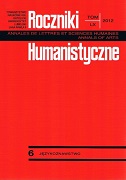Językowe sposoby opisu brzydkiego mężczyzny w literaturze baroku
The Linguistic Ways of Descriptions of Ugly Man in the Literature of the Polish Baroque
Author(s): Urszula Ciszewska-PsujekSubject(s): Language and Literature Studies
Published by: Towarzystwo Naukowe KUL & Katolicki Uniwersytet Lubelski Jana Pawła II
Keywords: uglyness; ugly; man; Baroque; Wacław Potocki
Summary/Abstract: The present article is an attempt to characterize linguistic ways of theme descriptions, and expressions of ugly man in the literature of the Polish Baroque. Delineation of methods of linguistic verbalization his physical form of ugliness, activities and behavior of states includes about several dozen selected texts of seventeenth-century writers: Wespazjan Kochowski, Jan Andrzej Morsztyn, Krzysztof Opali!ski, WacNaw Potocki, StanisNaw Samuel Szemiot, and others. Pejorative description of ugly man contains inadvisable features and their intensity or defects. Situational facetiousness shows physical eyesore, and negative characteristics or attitudes enumerations presents psycho-moral shortage. Old man is branded notably when he marries younger woman. Comparative analysis of baroque colloquial and poetic texts contains lexical, semantic, syntactic classification of the ways of language descriptions of ugly man.
Journal: Roczniki Humanistyczne
- Issue Year: 60/2012
- Issue No: 06
- Page Range: 181-201
- Page Count: 21
- Language: Polish

